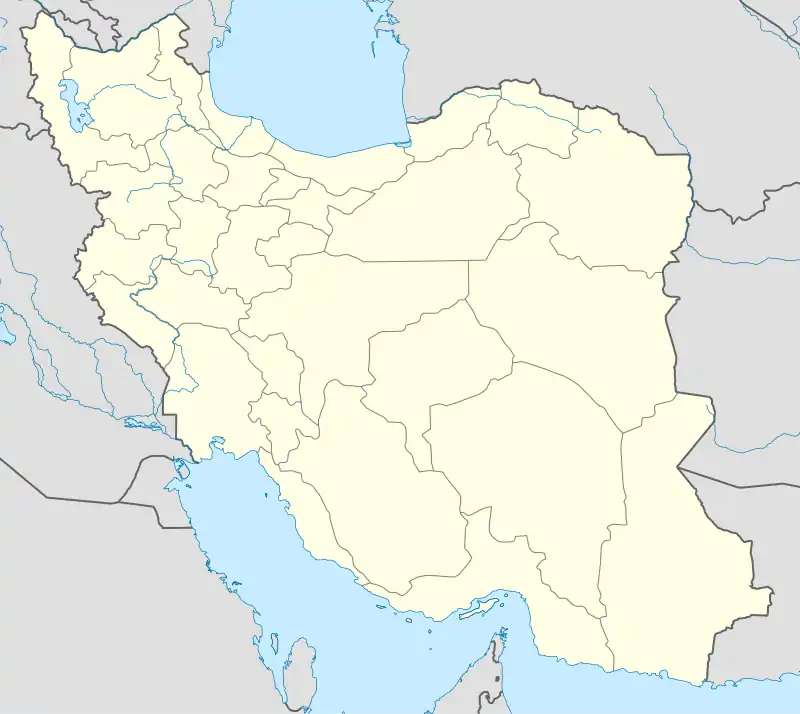| Mausoleum of Safavid Princes | |
|---|---|
 | |
| Religion | |
| Affiliation | Twelver Shi'a |
| District | Chaharsu-ye-Kuchak |
| Province | Isfahan Province |
| Location | |
| Location | Isfahan, Iran |
 Shown within Iran | |
| Geographic coordinates | 32°39′37″N 51°39′13″E / 32.660278°N 51.653611°E |
| Architecture | |
| Type | mausoleum |
| Style | Safavid, Qajar |
| Specifications | |
| Length | 24 metres |
| Width | 8.14 metres |
| Materials | bricks |
The Mausoleum of Safavid Princes (Persian: آرامگاه شاهزادگان صفوی) is a historic funerary monument in the Chaharsu-ye-Kuchak district of Isfahan, Iran. It entombs the remains of some of the great-grandsons of Safavid ruler, Shah Ismail I who were executed during the reign of Shah Safi.[1]
History
When Sam Mirza came to power as the new Shah of Iran and took the royal title of Shah Safi, he ruthlessly eliminated anyone he regarded as a threat to his power, executing almost all of the Safavid royal princes.[2] Some of these murdered or executed princes were entombed between the years 1631 to 1632 at the spot where the mausoleum is now.[3] The mausoleum was renovated in 1826 during the reign of Fath-Ali Shah Qajar.[4] An inscribed poem, dating back to the same year, reveals a name of a "Muhammad Ali Khan" who was responsible for the renovations.[5]
Tomb of Seti Fateme

On the west of the mausoleum is the Tomb of Seti Fateme (Persian: آرامگاه ستی فاطمه) which is believed to contain the grave of Siti Fatimah, a daughter of the seventh Imam of Ahlulbayt, Musa al-Kadhim.[4][5][1] This building dates back to the reign of Shah Abbas I. Despite the attribution, there is no historical evidence that a daughter of Musa al-Kadhim was buried there, nor is there any proof for her existence.[6] There is a private mausoleum for the influential families of Soltan Khalifa and Sadat Marashi in this area as well.[6][4][5]
See also
- List of historical structures in Isfahan for a more comprehensive list on the historical sites in Isfahan, Iran
- List of mausoleums in Iran for a complete list of mausoleums in Iran
References
- 1 2 Hosseyn Yaghoubi (2004). Arash Beheshti (ed.). Rāhnamā ye Safar be Ostān e Esfāhān (Travel Guide for the Province Isfahan) (in Persian). Rouzane. p. 119. ISBN 964-334-218-2.
- ↑ Hosseyn Yaghoubi (2004). Arash Beheshti (ed.). Rāhnamā ye Safar be Ostān e Esfāhān (Travel Guide for the Province Isfahan) (in Persian). Rouzane. p. 119. ISBN 964-334-218-2.
- ↑ سایت, مدیریت (2019-01-04). "آرامگاه معروف به ستی فاطمه". اینجا اصفهان (in Persian). Retrieved 2023-12-12.
- 1 2 3 "آشنایی با زیارتگاه ستی فاطمه اصفهان | مجله آنیجا". anyja.ir. Retrieved 2023-12-12.
- 1 2 3 "آشنایی با بقعه ستی فاطمه و شاهزادگان - اصفهان - همشهری آنلاین". www.hamshahrionline.ir. Retrieved 2023-12-12.
- 1 2 "آرامگاه ستی فاطمه و مقبره شاهزادگان | آدرس ، عکس و معرفی (1401)". کارناوال ☀️ راهنمای سفر | karnaval (in Persian). Retrieved 2023-12-12.